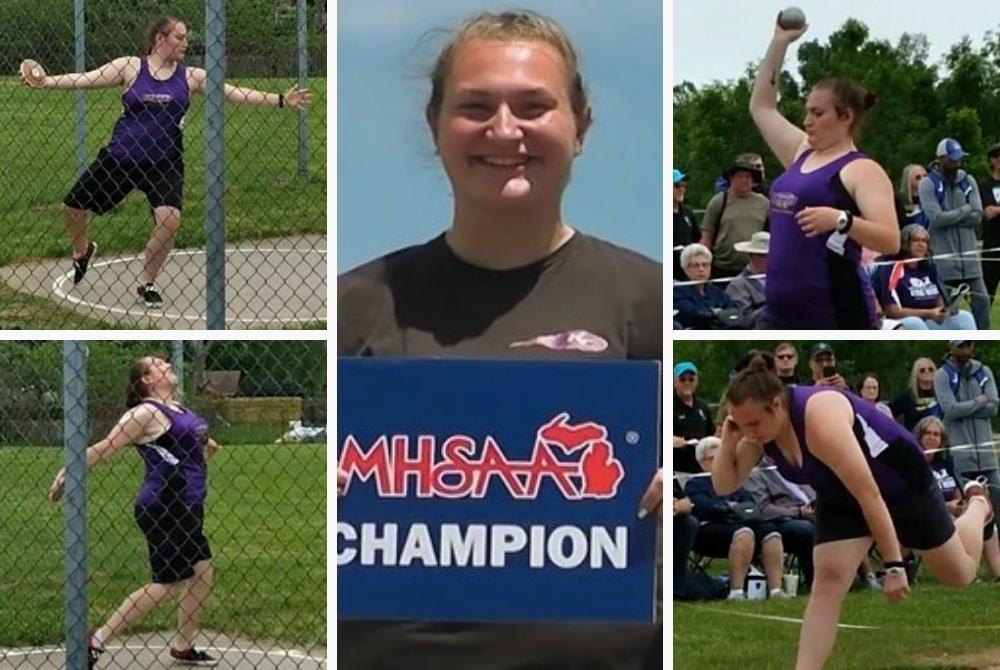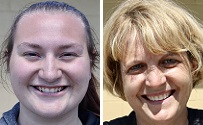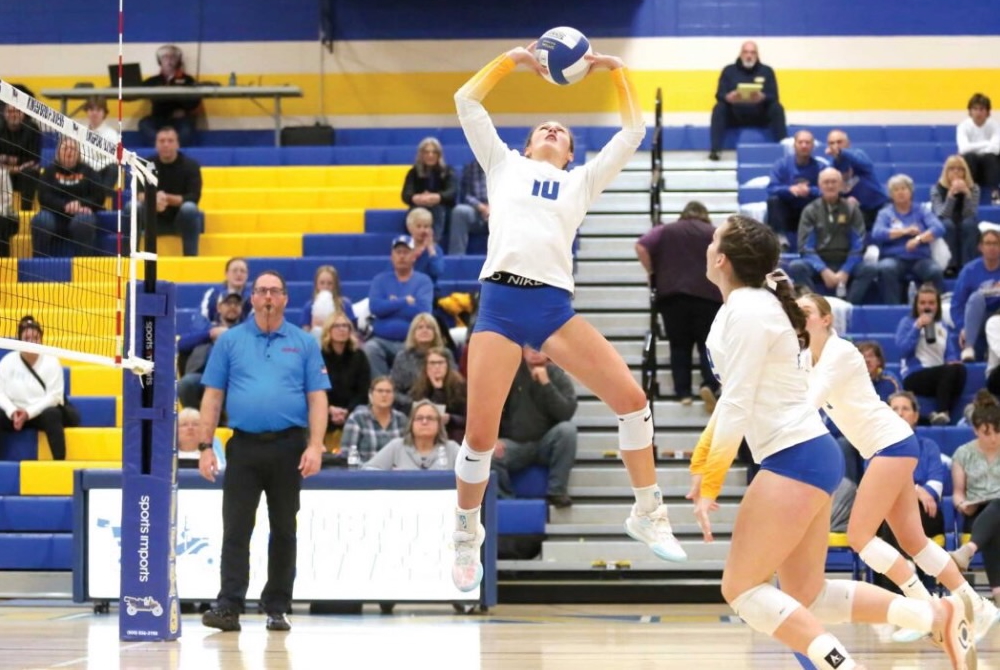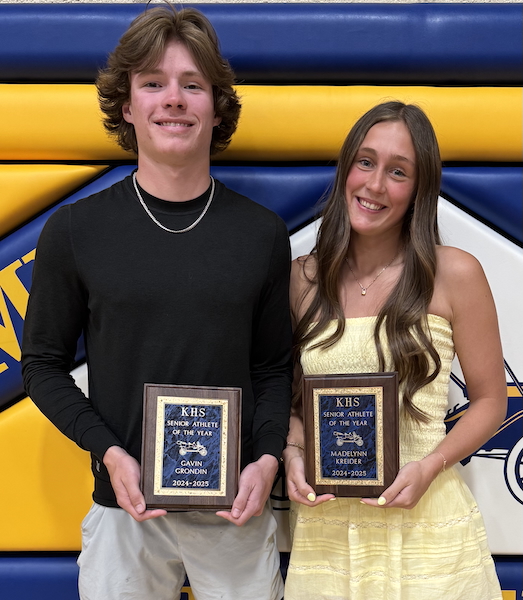
In Just 2nd Season, Van Dyk Breaks Decades-Old K-Christian Throws Records
By
Pam Shebest
Special for MHSAA.com
June 9, 2022
KALAMAZOO — When an exuberant Tess Van Dyk broke the shot put record at Kalamazoo Christian earlier this year, the senior was thrilled at reaching one of her high school goals.
 For her throws coach, Tracy (Rozema) Jackson, the achievement was bittersweet.
For her throws coach, Tracy (Rozema) Jackson, the achievement was bittersweet.
Jackson was the previous record-holder with a put of 41 feet, 6 inches, and knew that record was in jeopardy when she saw Van Dyk’s numbers a year ago.
“I thought, just wait and be prepared for it,” Jackson said. “It was kind of something sentimental. That record had been in place for 34 years. I set it in 1988.”
Van Dyk actually broke the record twice.
She put the shot 42 feet, 6 inches, to snap Jackson’s record, then the same day, threw the current mark of 42-9.
That happened during a dual meet April 21, and was just the start of a stellar year.
Van Dyk also shattered the previous discus throw record of 127 feet, 3 inches, set by Sandy (Wolthuis) George in 1978.
Van Dyk’s record-setter was 134-6, tossed at the Southwestern Athletic Conference championship meet May 24.
“When I started track, one of my big goals was to break either the shot put or discus record,” Van Dyk said. “I was like, before I leave this school, I want my name on that board.
“That’s what started me on the path to loving track and getting that grit for it.”
Since the records board has not yet been updated, the recent grad will have to return to the school to see her name up there. But her coach gave her a preview.
“I went into the gymnasium and I took a picture of the board with my name on it, then I covered it up with her name (using SnapChat),” Jackson said.
Those two records are not the only accolades Van Dyk has on her resume.
She owns three MHSAA Finals titles: the discus and shot last year and the shot this year at the MHSAA Lower Peninsula Division 4 Track & Field Championships.
In addition, she earned all-state honors both seasons.
The camaraderie and respect between the student and coach is evident as they talk and laugh, reviewing the last two years.
In fact, Van Dyk is headed this fall to Western Michigan University, her coach’s alma mater.
Jackson was on the college track team, but noted: “I do not have any records there, and none anymore, thanks to this one,” she said, nodding toward Van Dyk, laughing.
Since her sophomore season was scrubbed because of the statewide COVID-19 shutdown, Van Dyk’s first introduction to track & field was her junior year.
“I just naturally grew toward shot put and discus with the help of my coach and other people because I like running, but not competitively,” she said.
“Shot put you can kind of get your frustrations out. If you had a really bad day, you can just take up all that emotion and let it all go in that moment.”
 It is different for discus, she said. “For discus, you really get the calmness of it and then a quick little snap as you release it, just the feeling of knowing it’s a good one.”
It is different for discus, she said. “For discus, you really get the calmness of it and then a quick little snap as you release it, just the feeling of knowing it’s a good one.”
Van Dyk learned a few important lessons at the MHSAA Finals last year.
“In shot put, I had thrown a 41-foot before I went to states,” she said. “(Finals day) was a hot, steamy day. There wasn’t a cloud in sight.
“We were all getting beaten down by the weather. In throwing, you’re just standing there cooking. I had to push through it. I had a huge support team behind me and trusted that my body knew what it had to do.”
It knew enough to give Van Dyk, the top seed, the championship.
In discus, she was seeded third.
“I’d been struggling with that all year, so I had some bigger fish to fry,” she said. “As soon as I got up there, it was a windy day at Baldwin Middle School (in Hudsonville), and some of the big dogs started hitting the fence area around it.
“That was when I realized it doesn’t matter what their records are, you just have to do what you can do. Then I realized I could do it and got my head in the game and squeaked out a 112 (to win).”
Although Van Dyk repeated as shot put champ Saturday, she finished second in discus.
“It was honestly kind of funny, because the girl who beat me (Elli Stender of Gobles) was slated for third as well,” Van Dyk said, referring to her own junior year. “She’s a great girl. I’ve been competing against her all season, and she’s got great form.
“Everything worked together like what happened to me last year. I couldn’t be more grateful to celebrate with her. I am honestly proud of my second place.”
Looking at next season, Jackson said she would not mind if Van Dyk spent some time working with the K-Christian throwers.
“I thought I gave up my (coaching) position now that she took over control of the record,” Jackson joked. “I feel like she just has to walk over here (from WMU). She doesn’t even need gas.
“She does an amazing job with some of the other throwers. That came out this year.”
And not only with her own teammates.
Although the Comets and Hackett Catholic Prep are fierce crosstown rivals, Hackett coach Carl Scholten has respect for Van Dyk.
“She’s a great technician and she knows the events very well, knows the form, knows the techniques and the mechanics,” he said. “That makes her incredibly gifted in these events.
“It’s led to her great success. I love that, not only with her own team but with other kids, she’s wants to help develop other throwers, too. We had a couple of seniors out for the first time, and they really connected with her. She was a great model and inspiration for them.”
One thing the two schools have in common is their faith-based education, which is very important to Van Dyk.
That is also one reason she chose WMU.
“Coach Makiba Batten does not host practices on Sundays, which is a big thing for me,” Van Dyk said. “It’s so close to home, I don’t have to switch churches and that was a big thing, too.”
She also enjoys talking with others about her religion.
When she was getting her shirt for this season, instead of her name she had SDG on the back.
“People ask all the time why I have SDG on my back,” she said. “I say, ‘Glad you asked.’ It stands for Soli Deo Gloria: to God be the glory alone.
“It’s just a reminder to me every time I throw that it’s not me who’s throwing, it’s Him who gave me strength.”
Jackson, who is coordinator of surgery at Bronson Methodist Hospital in Kalamazoo, said if she has one thing to say to Van Dyk, it is: “The discipline you put in for the discus and the shot, just continue that in your life, and especially in your spiritual walk. I know how important your church is. Remember the ultimate glory is His.”
 Pam Shebest served as a sportswriter at the Kalamazoo Gazette from 1985-2009 after 11 years part-time with the Gazette while teaching French and English at White Pigeon High School. She can be reached at [email protected] with story ideas for Calhoun, Kalamazoo and Van Buren counties.
Pam Shebest served as a sportswriter at the Kalamazoo Gazette from 1985-2009 after 11 years part-time with the Gazette while teaching French and English at White Pigeon High School. She can be reached at [email protected] with story ideas for Calhoun, Kalamazoo and Van Buren counties.
PHOTOS (Top) Kalamazoo Christian’s Tess Van Dyk, pictured at center on the awards podium at Saturday’s LPD4 Finals, closed her career as her school’s record holder in discus and shot put. (Middle) Van Dyk, left, and Kalamazoo Christian throws coach Tracy Jackson. (Action photos courtesy of Kathy Van Dyk, Finals photo by State Champs! Sports Network, and head shots by Pam Shebest.)

Kingsford's Kreider Prepared for Next Level After Finishing Stellar Flivvers Career
By
John Vrancic
Special for MHSAA.com
June 19, 2025
KINGSFORD — After completing a successful high school volleyball career, Maddy Kreider is ready to take the next step.
 The Kingsford senior is taking her talents to Michigan Tech, where she’s expected to continue primarily as a setter.
The Kingsford senior is taking her talents to Michigan Tech, where she’s expected to continue primarily as a setter.
“That will be a big step for sure, but it’ll be exciting being with the girls,” she said. “The girls are taller in college. It will definitely be an adjustment, physically and mentally. We’ll be traveling longer distances, and it’ll be a matter of improving the mental part of my game.”
Kreider was selected the Upper Peninsula’s Defensive Player of the Year her final two seasons after the U.P. Sportswriters and Sportscasters Association began voting for all-U.P. volleyball.
“That’s quite an accomplishment,” she said. “It’s a real honor playing with girls I grew up with. We had a great season.”
The 5-foot-8 setter was a four-year starter and two-year team captain at Kingsford, leading the Flivvers to three Division 2 District titles and back-to-back undefeated Great Northern Conference championships. She twice was named GNC Player of the Year.
She was also selected all-state first team in the fall and all-state second team in 2023, and all-region throughout her prep career. Her serving percentage also topped .900 throughout her four seasons on varsity.
 Last fall, the Flivvers reached the Regional Semifinal at Manistique where they dropped a 3-2 decision to Kingsley.
Last fall, the Flivvers reached the Regional Semifinal at Manistique where they dropped a 3-2 decision to Kingsley.
“I thought we’d get through,” Kreider said. “We came out lights out in the first two sets, then it was close in the last three.”
Also among the team’s highlights this past fall was a victory at Calumet, approximately 2½ weeks after dropping a 3-1 decision to the Copper Kings on Kingsford’s home floor.
“We wanted to play them,” Kreider said. “They’re a great bunch of girls to play against. They’ve been the measuring stick up here for many years. Winning on their floor was super exciting. We knew we had to play well just to be competitive. That was a great confidence builder for our group. We were definitely on a high going into the District.”
The Flivvers opened their postseason with a 3-1 triumph over Houghton, then defeated Escanaba in straight sets in the District Final.
Kreider will join Calumet senior Maddie Torola at MTU this fall. Torola, who recorded a season-high 19 kills in the four-set victory at Kingsford, helped the Copper Kings finish 29-5 and reach the Division 3 Regional Final at Sault Ste. Marie where they dropped a 3-2 decision to Traverse City St. Francis.
“It was fun playing against her in high school,” Kreider said. “It will be even more fun playing as teammates. It’ll be exciting to be playing on the same team.”
Both will be playing under new head coach Cindy Pindral at Tech. Both of Kreider’s parents played for the Huskies, her mother (and Kingsford varsity coach) Jaclynn volleyball from 1998-2002 and her father Jason basketball from 1997-2000.
Maddy Kreider recently earned an additional honor when she was selected Female Athlete of the Year for Kingsford’s Class of 2025. She recently completed a solid track & field season for the Flivvers.
At the U.P. Division 1 Finals, Kreider placed fourth in the 100-meter dash (13.2) and anchored the Flivvers to a third-place finish in the 800 relay (1:51.57) and fourth in the 400 (53.03) on their home track.
Kreider was named one of 32 MHSAA/Farm Bureau Insurance Scholar-Athlete Award winners this winter and plans to study exercise science and kinesiology at MTU.
 John Vrancic has covered high school sports in the Upper Peninsula since joining the Escanaba Daily Press staff in 1985. He is known most prominently across the peninsula for his extensive coverage of cross country and track & field that frequently appears in newspapers from the Wisconsin border to Lake Huron. He received the James Trethewey Award for Distinguished Service in 2015 from the Upper Peninsula Sportswriters and Sportscasters Association.
John Vrancic has covered high school sports in the Upper Peninsula since joining the Escanaba Daily Press staff in 1985. He is known most prominently across the peninsula for his extensive coverage of cross country and track & field that frequently appears in newspapers from the Wisconsin border to Lake Huron. He received the James Trethewey Award for Distinguished Service in 2015 from the Upper Peninsula Sportswriters and Sportscasters Association.
PHOTOS (Top) Kingsford’s Maddy Kreider sets for her teammates during a match last season. (Middle) Kreider, right, takes a photo with Kingsford’s Male Athlete of the Year Gavin Grondin. (Photos provided by the Kingsford athletic department.)

